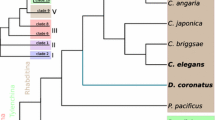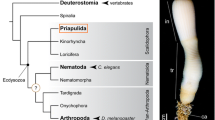Abstract
Polymerase chain reaction-restriction fragment length polymorphism) was performed on the cistron of rDNA in the two groups of infective larvae Trichostrongylus colubriformis—the population with and without ability to undergo arrested development. General primers designed by Caenorhabditis elegans rDNA were used for the amplification of the rDNA cistron between genes 18S and 28S. Amplified fragments were digested by using a series of restriction endonucleases. Hinc II restriction profiles unique for each T. colubriformis populations were observed, and therefore enzyme Hinc II appears to be useful for the determination of populations with and without the ability to undergo arrested development. Molecular markers of arrested development ability have not been studied on this part of rDNA before.



Similar content being viewed by others
References
Braasch H, Metge K, Burgermeister W (1999) Bursaphelenchus species in conifers in Germany and their ITS-RFLP pattern. Nachrichtenblatt des Deutschen Pflanzenschutzdiensts 51:312–320
Conole JC, Chilton NB, Jarvis T, Gasser RB (1999) Intraspecific and interspecific variation in the second internal transcribed spacer (ITS-2) sequence for Metastrongylus (Nematoda: Metastrongyloidea) detected by high resolution PCR-RFLP. Int J Parasitol 29:1935–1940
De Silva LM, Miranda RR, Santos HA, Rabelo EM (2006) Differential diagnosis of dog hookworms based on PCR-RFLP from the ITS region of their rDNA. Vet Parasitol 140:373–377
Eysker M (1993) The role of inhibited development in the epidemiology of Ostertagia infections. Vet Parasitol 46:259–269
Eysker M (1997) Some aspects of inhibited development of trichostrongylids in ruminants. Vet Parasitol 72:265–283
Fernández AS, Fiel CA, Stefan PE (1999) Study on the inductive factors of hypobiosis of Ostertagia ostertagi in cattle. Vet Parasitol 81:295–307
Freitas TC, Arasu P (2005) Cloning and characterisation of genes encoding two transforming growth factor-M-like ligands from the hookworm, Ancylostoma caninum. Int J Parasitol 35:1477–1487
Gasser RB, Hoste H (1995) Genetic markers for closely-related parasitic nematodes. Mol Cell Probe 9:315–320
Gasser RB, Chilton NB, Hoste H, Beveridge I (1993) Rapid sequencing of rDNA from single worms and eggs of parasitic helminths. Nucleic Acids Res 21:2525–2526
Hoste H, Chilton NB, Gasser RB, Beveridge I (1995) Differences in the second internal transcribed spacer (ribosomal DNA) between five species of Trichostrongylus (nematoda: Trichostrongylida). Int J Parasitol 25:75–80
Langrová I, Jankovská I (2004) Arrested development of Trichostrongylus colubriformis in experimentally infected rabbits. Effect of decreasing photoperiod, low temperature and desiccation. Helminthologia 41:85–90
McMurtry LW, Donaghy MJ, Vlassoff A, Douch PGC (2000) Distinguishing morphological features of the third larval stage of ovine Trichostrongylus spp. Vet Parasitol 90:73–81
Nuchprayoon S, Junpee A, Nithiuthai S, Chungpivat S, Suvannadabba S, Poovorawan Y (2006) Detection of filarial parasites in domestic cats by PCR-RFLP of ITS1. Vet Parasitol 140:366–372
Ren PF, Lim CS, Johnsen R, Albert PS, Pilgrim D, Riddle DL (1996) Control of C. elegans larval development by neuronal expression of a TGF-beta homolog. Science 274:1389–1391
Rickling S (1999) Vergleichende Untersuchungen zur Genexpression persistierender und nicht persistierender Stadien von Dictyocaulus viviparus. PhD thesis, Tierärztliche Hochschule Hannover, 186 pp
Sommerville RI, Davey KG (2002) Diapause in parasitic nematodes: a review. Can J Zool 80:1817–1840
Strube Ch (2004) Differentielle Gentranskription bei Hypobiose induzierten und nicht induzierten dritten Larven von Dictyocaulus viviparus. PhD thesis, Tierärztliche Hochschule Hannover, 269 pp
Zhu X, Gasser RB, Jacobs DE, Hung GC, Chilton NB (2000) Relationships among some ascaridoid nematodes based on ribosomal DNAsequence data. Parasitol Res 86:738–744
Acknowledgments
This study was supported by the Research Project of the Faculty of Agrobiology, Food and Natural Resources, Czech University of Life Sciences Prague, No. MSM 6046070901. Experiments comply with current laws of the country in which they were performed.
Author information
Authors and Affiliations
Corresponding author
Rights and permissions
About this article
Cite this article
Langrová, I., Zouhar, M., Vadlejch, J. et al. Trichostrongylus colubriformis rDNA polymorphism associated with arrested development. Parasitol Res 103, 401–403 (2008). https://doi.org/10.1007/s00436-008-0987-3
Received:
Accepted:
Published:
Issue Date:
DOI: https://doi.org/10.1007/s00436-008-0987-3




